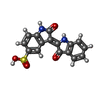[English] 日本語
 Yorodumi
Yorodumi- PDB-1e9h: Thr 160 phosphorylated CDK2 - Human cyclin A3 complex with the in... -
+ Open data
Open data
- Basic information
Basic information
| Entry | Database: PDB / ID: 1e9h | ||||||
|---|---|---|---|---|---|---|---|
| Title | Thr 160 phosphorylated CDK2 - Human cyclin A3 complex with the inhibitor indirubin-5-sulphonate bound | ||||||
 Components Components |
| ||||||
 Keywords Keywords | CELL CYCLE / COMPLEX (PROTEIN KINASE-CYCLIN) / KINASES / INHIBITOR / CYCLIN / COMPLEX / PHOSPHORYLATION | ||||||
| Function / homology |  Function and homology information Function and homology information: / cyclin A2-CDK1 complex / cell cycle G1/S phase transition / cellular response to luteinizing hormone stimulus / Transcription of E2F targets under negative control by p107 (RBL1) and p130 (RBL2) in complex with HDAC1 / cellular response to leptin stimulus / male pronucleus / female pronucleus / cellular response to cocaine / response to glucagon ...: / cyclin A2-CDK1 complex / cell cycle G1/S phase transition / cellular response to luteinizing hormone stimulus / Transcription of E2F targets under negative control by p107 (RBL1) and p130 (RBL2) in complex with HDAC1 / cellular response to leptin stimulus / male pronucleus / female pronucleus / cellular response to cocaine / response to glucagon / positive regulation of DNA biosynthetic process / cyclin-dependent protein serine/threonine kinase regulator activity / cellular response to insulin-like growth factor stimulus / cyclin A1-CDK2 complex / cyclin E2-CDK2 complex / cyclin E1-CDK2 complex / cyclin A2-CDK2 complex / positive regulation of DNA-templated DNA replication initiation / G2 Phase / Y chromosome / cyclin-dependent protein kinase activity / Phosphorylation of proteins involved in G1/S transition by active Cyclin E:Cdk2 complexes / positive regulation of heterochromatin formation / p53-Dependent G1 DNA Damage Response / X chromosome / PTK6 Regulates Cell Cycle / regulation of anaphase-promoting complex-dependent catabolic process / Defective binding of RB1 mutants to E2F1,(E2F2, E2F3) / centriole replication / Regulation of APC/C activators between G1/S and early anaphase / regulation of DNA replication / telomere maintenance in response to DNA damage / microtubule organizing center / centrosome duplication / G0 and Early G1 / cochlea development / Telomere Extension By Telomerase / animal organ regeneration / Activation of the pre-replicative complex / cyclin-dependent kinase / cyclin-dependent protein serine/threonine kinase activity / TP53 Regulates Transcription of Genes Involved in G1 Cell Cycle Arrest / Activation of ATR in response to replication stress / Regulation of MITF-M-dependent genes involved in cell cycle and proliferation / Cajal body / Cyclin E associated events during G1/S transition / Cyclin A:Cdk2-associated events at S phase entry / Cyclin A/B1/B2 associated events during G2/M transition / cyclin-dependent protein kinase holoenzyme complex / cellular response to platelet-derived growth factor stimulus / regulation of G2/M transition of mitotic cell cycle / condensed chromosome / mitotic G1 DNA damage checkpoint signaling / cellular response to nitric oxide / post-translational protein modification / regulation of mitotic cell cycle / cyclin binding / positive regulation of DNA replication / meiotic cell cycle / male germ cell nucleus / Cdc20:Phospho-APC/C mediated degradation of Cyclin A / cellular response to estradiol stimulus / G1/S transition of mitotic cell cycle / peptidyl-serine phosphorylation / potassium ion transport / DNA Damage/Telomere Stress Induced Senescence / CDK-mediated phosphorylation and removal of Cdc6 / Meiotic recombination / SCF(Skp2)-mediated degradation of p27/p21 / G2/M transition of mitotic cell cycle / Transcriptional regulation of granulopoiesis / positive regulation of fibroblast proliferation / Orc1 removal from chromatin / Cyclin D associated events in G1 / cellular senescence / Regulation of TP53 Degradation / nuclear envelope / Factors involved in megakaryocyte development and platelet production / Processing of DNA double-strand break ends / regulation of gene expression / Senescence-Associated Secretory Phenotype (SASP) / transcription regulator complex / cellular response to hypoxia / Regulation of TP53 Activity through Phosphorylation / Ras protein signal transduction / DNA replication / chromosome, telomeric region / protein phosphorylation / endosome / Ub-specific processing proteases / chromatin remodeling / protein domain specific binding / cell division / protein serine kinase activity / DNA repair / protein serine/threonine kinase activity / positive regulation of cell population proliferation / DNA-templated transcription / centrosome / protein kinase binding Similarity search - Function | ||||||
| Biological species |  HOMO SAPIENS (human) HOMO SAPIENS (human) | ||||||
| Method |  X-RAY DIFFRACTION / X-RAY DIFFRACTION /  SYNCHROTRON / SYNCHROTRON /  MOLECULAR REPLACEMENT / Resolution: 2.5 Å MOLECULAR REPLACEMENT / Resolution: 2.5 Å | ||||||
 Authors Authors | Davies, T.G. / Tunnah, P. / Noble, M.E.M. / Endicott, J.A. | ||||||
 Citation Citation |  Journal: Structure / Year: 2001 Journal: Structure / Year: 2001Title: Inhibitor Binding to Active and Inactive Cdk2: The Crystal Structure of Cdk2-Cyclin A/Indirubin-5-Sulphonate Authors: Davies, T.G. / Tunnah, P. / Meijer, L. / Marko, D. / Eisenbrand, G. / Endicott, J.A. / Noble, M.E. | ||||||
| History |
|
- Structure visualization
Structure visualization
| Structure viewer | Molecule:  Molmil Molmil Jmol/JSmol Jmol/JSmol |
|---|
- Downloads & links
Downloads & links
- Download
Download
| PDBx/mmCIF format |  1e9h.cif.gz 1e9h.cif.gz | 238.5 KB | Display |  PDBx/mmCIF format PDBx/mmCIF format |
|---|---|---|---|---|
| PDB format |  pdb1e9h.ent.gz pdb1e9h.ent.gz | 192.1 KB | Display |  PDB format PDB format |
| PDBx/mmJSON format |  1e9h.json.gz 1e9h.json.gz | Tree view |  PDBx/mmJSON format PDBx/mmJSON format | |
| Others |  Other downloads Other downloads |
-Validation report
| Summary document |  1e9h_validation.pdf.gz 1e9h_validation.pdf.gz | 555.4 KB | Display |  wwPDB validaton report wwPDB validaton report |
|---|---|---|---|---|
| Full document |  1e9h_full_validation.pdf.gz 1e9h_full_validation.pdf.gz | 607.6 KB | Display | |
| Data in XML |  1e9h_validation.xml.gz 1e9h_validation.xml.gz | 30.2 KB | Display | |
| Data in CIF |  1e9h_validation.cif.gz 1e9h_validation.cif.gz | 45.7 KB | Display | |
| Arichive directory |  https://data.pdbj.org/pub/pdb/validation_reports/e9/1e9h https://data.pdbj.org/pub/pdb/validation_reports/e9/1e9h ftp://data.pdbj.org/pub/pdb/validation_reports/e9/1e9h ftp://data.pdbj.org/pub/pdb/validation_reports/e9/1e9h | HTTPS FTP |
-Related structure data
| Related structure data | |
|---|---|
| Similar structure data |
- Links
Links
- Assembly
Assembly
| Deposited unit | 
| ||||||||
|---|---|---|---|---|---|---|---|---|---|
| 1 | 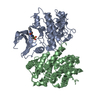
| ||||||||
| 2 | 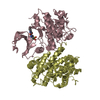
| ||||||||
| Unit cell |
| ||||||||
| Noncrystallographic symmetry (NCS) | NCS oper: (Code: given Matrix: (-0.999932, -0.011239, 0.003138), Vector: |
- Components
Components
| #1: Protein | Mass: 33873.195 Da / Num. of mol.: 2 Source method: isolated from a genetically manipulated source Details: PHOSPHORYLATED ON THR 160 CHAINS A AND C ARE ASYMETRIC UNIT COPIES Source: (gene. exp.)  HOMO SAPIENS (human) / Production host: HOMO SAPIENS (human) / Production host:  #2: Protein | Mass: 29964.713 Da / Num. of mol.: 2 Source method: isolated from a genetically manipulated source Details: TRUNCATED FRAGMENT OF CYCLIN A. IN COMPLEX WITH CDK2 CHAINS B AND D ARE ASYMETRIC UNIT COPIES Source: (gene. exp.)  HOMO SAPIENS (human) / Production host: HOMO SAPIENS (human) / Production host:  #3: Chemical | #4: Water | ChemComp-HOH / | Compound details | THE CDK2 SHOWS MAXIMAL ACTIVITY DURING S PHASE AND G2 AND INTERACTS WITH CYCLINS A, D, OR E. IT IS ...THE CDK2 SHOWS MAXIMAL ACTIVITY DURING S PHASE AND G2 AND INTERACTS WITH CYCLINS A, D, OR E. IT IS PROBABLY INVOLVED IN THE CONTROL OF THE CELL CYCLE. CYCLIN IS ESSENTIAL FOR THE CONTROL OF THE CELL CYCLE AT THE G1/S(START) AND THE G2/M (MITOSIS) TRANSITION | Has protein modification | Y | |
|---|
-Experimental details
-Experiment
| Experiment | Method:  X-RAY DIFFRACTION / Number of used crystals: 1 X-RAY DIFFRACTION / Number of used crystals: 1 |
|---|
- Sample preparation
Sample preparation
| Crystal | Density Matthews: 2.91 Å3/Da / Density % sol: 57.71 % | ||||||||||||||||||||||||||||||||||||||||||||||||||||||||||||||||||
|---|---|---|---|---|---|---|---|---|---|---|---|---|---|---|---|---|---|---|---|---|---|---|---|---|---|---|---|---|---|---|---|---|---|---|---|---|---|---|---|---|---|---|---|---|---|---|---|---|---|---|---|---|---|---|---|---|---|---|---|---|---|---|---|---|---|---|---|
| Crystal grow | pH: 7 / Details: pH 7.00 | ||||||||||||||||||||||||||||||||||||||||||||||||||||||||||||||||||
| Crystal grow | *PLUS Method: vapor diffusion, hanging drop | ||||||||||||||||||||||||||||||||||||||||||||||||||||||||||||||||||
| Components of the solutions | *PLUS
|
-Data collection
| Diffraction | Mean temperature: 100 K |
|---|---|
| Diffraction source | Source:  SYNCHROTRON / Site: SYNCHROTRON / Site:  ESRF ESRF  / Beamline: ID14-2 / Wavelength: 0.933 / Beamline: ID14-2 / Wavelength: 0.933 |
| Detector | Date: Apr 15, 2000 |
| Radiation | Protocol: SINGLE WAVELENGTH / Monochromatic (M) / Laue (L): M / Scattering type: x-ray |
| Radiation wavelength | Wavelength: 0.933 Å / Relative weight: 1 |
| Reflection | Resolution: 2.5→20 Å / Num. obs: 47127 / % possible obs: 90.1 % / Redundancy: 3 % / Rmerge(I) obs: 0.109 / Net I/σ(I): 4.1 |
| Reflection shell | Resolution: 2.5→2.59 Å / Redundancy: 2.3 % / Rmerge(I) obs: 0.39 / Mean I/σ(I) obs: 1.9 / % possible all: 90.1 |
| Reflection | *PLUS Highest resolution: 2.5 Å / Lowest resolution: 20 Å / Num. measured all: 143005 / Rmerge(I) obs: 0.103 |
| Reflection shell | *PLUS % possible obs: 63.8 % / Rmerge(I) obs: 0.388 |
- Processing
Processing
| Software |
| ||||||||||||||||||||||||||||||||||||||||||||||||||||||||||||
|---|---|---|---|---|---|---|---|---|---|---|---|---|---|---|---|---|---|---|---|---|---|---|---|---|---|---|---|---|---|---|---|---|---|---|---|---|---|---|---|---|---|---|---|---|---|---|---|---|---|---|---|---|---|---|---|---|---|---|---|---|---|
| Refinement | Method to determine structure:  MOLECULAR REPLACEMENT MOLECULAR REPLACEMENTStarting model: UNPUBLISHED STRUCTURE Resolution: 2.5→100 Å / Cross valid method: THROUGHOUT / σ(F): 0
| ||||||||||||||||||||||||||||||||||||||||||||||||||||||||||||
| Refinement step | Cycle: LAST / Resolution: 2.5→100 Å
| ||||||||||||||||||||||||||||||||||||||||||||||||||||||||||||
| Refine LS restraints |
| ||||||||||||||||||||||||||||||||||||||||||||||||||||||||||||
| Software | *PLUS Name: CNS / Version: 1 / Classification: refinement | ||||||||||||||||||||||||||||||||||||||||||||||||||||||||||||
| Refinement | *PLUS Lowest resolution: 100 Å | ||||||||||||||||||||||||||||||||||||||||||||||||||||||||||||
| Solvent computation | *PLUS | ||||||||||||||||||||||||||||||||||||||||||||||||||||||||||||
| Displacement parameters | *PLUS |
 Movie
Movie Controller
Controller


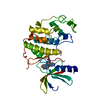
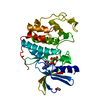
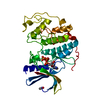
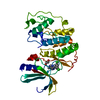
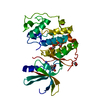
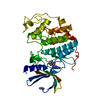
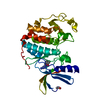
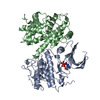
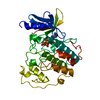
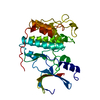
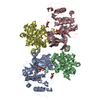
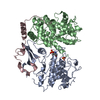
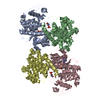
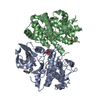
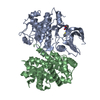
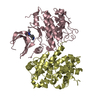
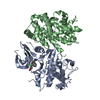
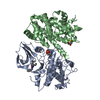
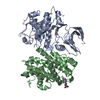
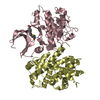
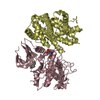
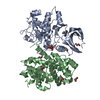
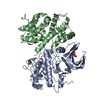
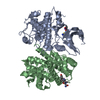
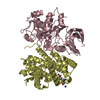

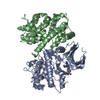
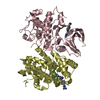
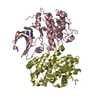
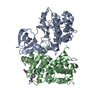
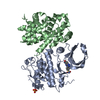
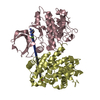
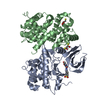
 PDBj
PDBj










